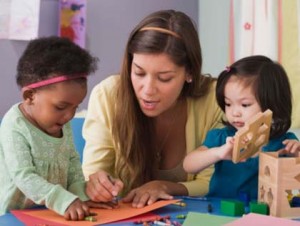
High-quality preschool programs can boost language and literacy
skills and, ultimately, reading achievement. But quality is essential,
and many preschools fall short in promoting language and literacy.
In a high-quality preschool, the teacher should provide a good model
of verbal language throughout the day. For example, when a child points
a finger and says “Dat,” the teacher has a number of good choices. She
could expand for him and say, “You want the red ball?” or she could say,
gently, “Tell me what you want,” or “Tell me what you want in words.”
Some teachers say, “Use your words,” but accept the closest approxima-
tion that they think the child can produce. She should also have informal
conversations with each child every day, encouraging them to use lan-
guage by asking open-ended questions, such as why, how, and what-if.
Preschools should help children to learn, think, and talk about new do-
mains of knowledge. They do this by providing opportunities for children to
use language in a variety of ways, by ensuring lots of interesting conversa-
tions in which children are involved, by offering opportunity to play with
language in ways that support phonological awareness and by incorporat-
ing meaningful uses of literacy into everyday activities.  . They are more likely to relate to stories, recognize
. They are more likely to relate to stories, recognize
words in them, and to understand events described in books.

Leave a Reply
You must be logged in to post a comment.